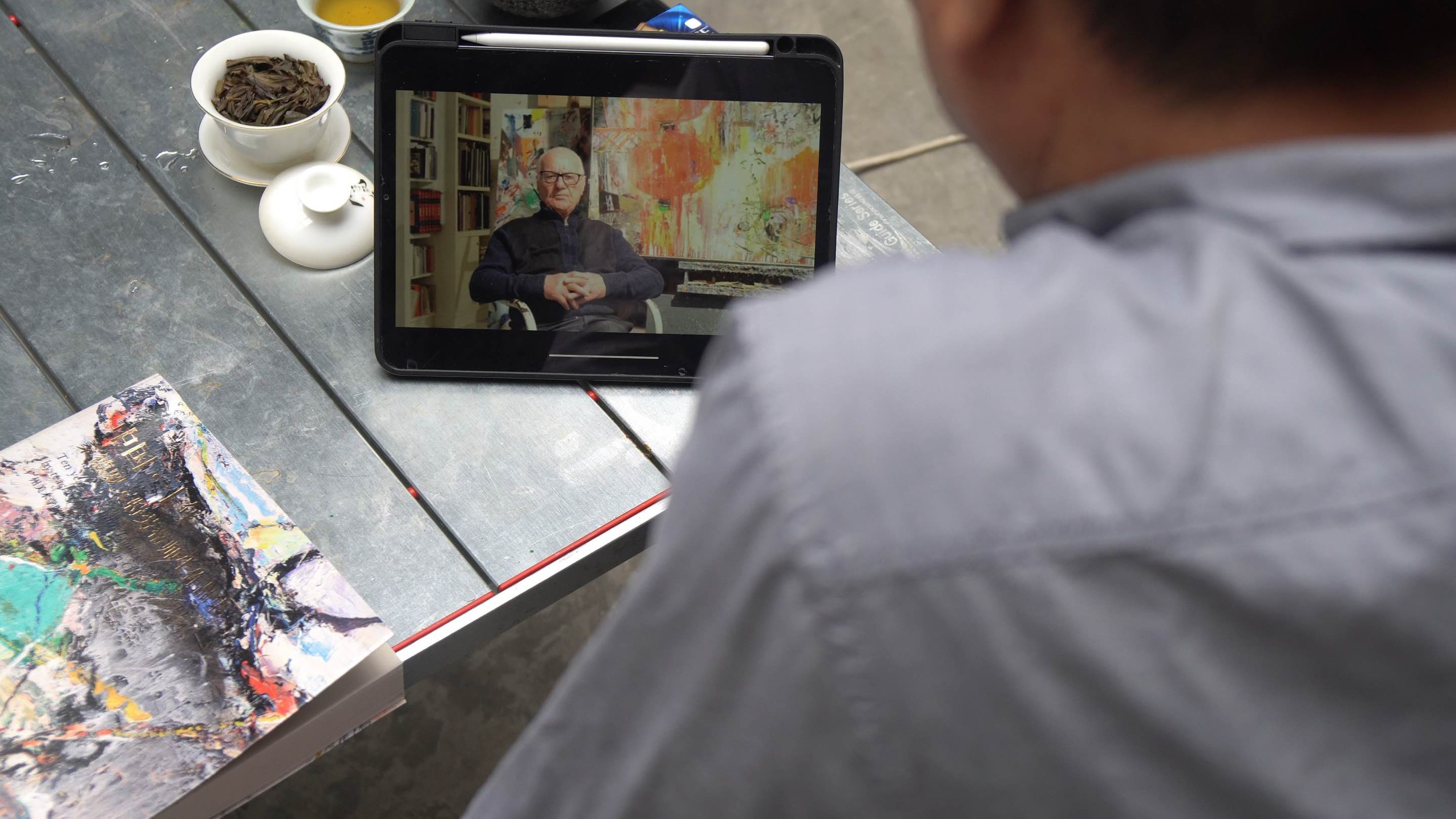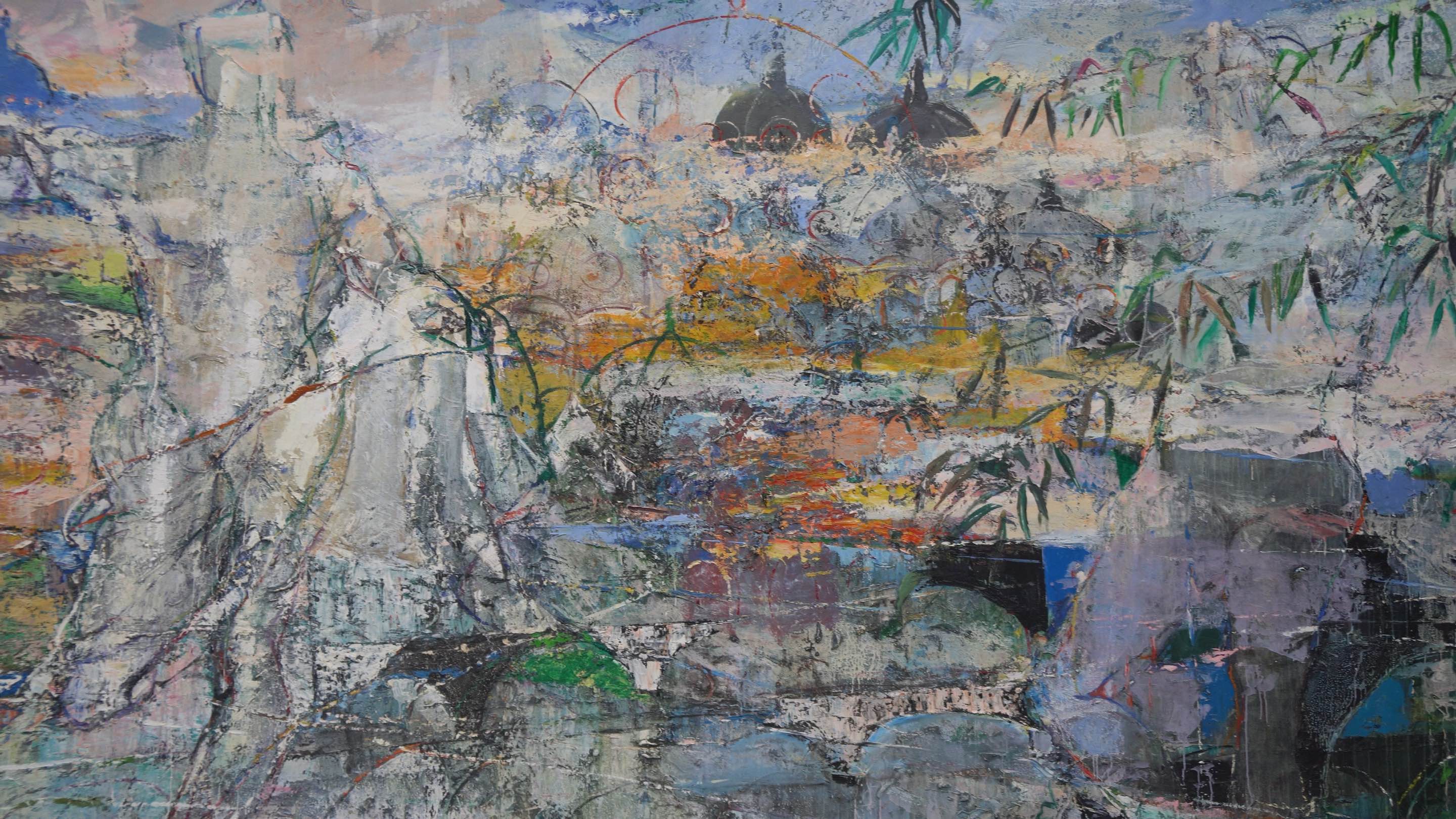The year 2024 marks the 700th anniversary of Marco Polo's death. In the Yuan Dynasty, what the Italian traveler saw and heard during his visit to China via the Silk Road became a window for Western minds to understand the mysterious East. The appeal of The Travels of Marco Polo lingers even today.
On April 29, GDToday reporters interviewed Professor Lei Xiaozhou, former Dean of Guangzhou Academy of Fine Arts (GAFA), City School, and Honorary Chairman of the Sino-Italian Art Research Association, at his studio in Guangzhou.
He introduced how Sandro Trotti, a contemporary Italian painter, perceives Marco Polo's image of China through artistic creation and exchanges in the 21st century. It is reported that Trotti's oil painting series titled The Reverie of Marco Polo, curated by Professor Lei, will be exhibited at the Guangzhou Opera House on May 4.

Prof. Lei Xiaozhou watches Trotti's video (Wingheng|GDToday )
An unprecedented experience of teaching across borders each year for over ten consecutive years
In 2005, GAFA was looking for a professor from Europe to teach oil painting. One teacher was then dispatched to Europe, searching for such candidates, but all the arduous attempts turned out to be in vain. Later, by chance, he got to know about Trotti through a friend. Trotti's combination of traditional oil painting techniques and modern artistic expression could not have been more suitable for adoption in art teaching in China. In the same year, Trotti was invited and came to teach at GAFA.
Despite teaching at the same school, they did not know each other. Lei and Trotti established a friendship in Sanjiang County, Guangxi Zhuang Autonomous Region in 2007. Lei, an oil painting teacher at GAFA at the time, took his students on a travel sketching trip there. Trotti, who was a teacher at the Central Academy of Fine Arts in Beijing, had also selected the place as the destination for his students' sketching expedition. Lei saw the works painted by Trotti and his students. When leaving for home, the 73-year-old Trotti asked Lei for a ride as he had stayed so long that he did not feel well and hoped to recuperate. Two oil painters soon became friends in the deep mountains.
From the incident in Sanjiang County in 2007 to Trotti's annual invitationto teach at GAFA since 2010, Lei and Trotti have been interacting with each other for two decades or so. Prof. Lei confessed that in terms of time span, there is no such example in the history of Chinese art education exchanges.

Prof. Lei Xiaozhou with Trotti (Photo by the interviewer)
Marco Polo is also a key to artistic exchange between China and Italy
Born by the sea in the Marche region of Italy, the hometown of Raphael, one of the three great masters of the Renaissance, and of Matteo Ricci, the missionary who first introduced oil painting to China, Trotti was influenced by them in his childhood. He sometimes asked why the sun rose from the east in the morning and why it could not rise from the west. The sight of the sun rising from the horizon sparked Trotti's curiosity and instilled in him a desire to explore the mysterious oriental country. Since an early age, Trotti had a Marco Polo-esque yearning for the East.
In 2015, he embarked on a series of The Reverie of Marco Polo. By reading a large number of Chinese classics and classical novels, including the Tao Te Ching, Dream of the Red Chamber, and Journey to the West, he finally presented a holistic image of China in his eyes using Western oil painting techniques. One of the pieces mainly consists of bridges from left to right and is embellished with two cultural symbols: Roman domes and Chinese bamboos.

One piece of series of The Reveries of Marco Polo (Wingheng|GDToday)
According to Prof. Lei, the real shift of Trotti's artistic style came after his arrival in China, especially in 2016, the year in which Lei took him to the Xi'an Museum. After seeing the murals in the tombs of the Tang Dynasty in China, Trotti experienced insomnia all night and was completely captivated. He saw for himself the mystery of Chinese legends, and took in the murals at a single glance. These murals are the true expression of oriental art in his dream.
Trotti has been contemplating how to better develop Western art. It is necessary to seek inspiration from the other end of the earth, namely, the East, and combine its essential elements with Western art. Only in this way is it possible to cultivate a new approach to oil painting and explore new possibilities. The main issue that Trotti reflects on is how to construct a bridge between the East and the West. The Reverie of Marco Polo is his personal endeavor.

Prof. Lei Xiaozhou interprets a piece of The Reverie of Marco Polo (Wingheng|GDToday)
Lei hopes to follow the footsteps of Marco Polo and lead Chinese artists to Italy by vehicle
Given extensive interactions with Trotti in recent years, Prof. Lei has taken the lead in establishing the Sino-Italian Art Research Association. Correspondingly, Trotti has also established the Italian-Chinese Art Research Association in Italy. Chinese artists will be curated for annual exhibitions in Italy each year in a couple of years. Through residential workshops offered by the research association, Chinese artists are encouraged to go to Italy for sketching and painting. At the same time, young Italian artists will be arranged to visit China for exchanges and artistic creation, and then exhibit their works in China.
In order to explore the origin of Eastern and Western art, Lei had an idea. Just like Marco Polo came to China from Italy via Central Asia on horseback and camelback, could Chinese artists set off from Guangzhou to Rome via a recreational vehicle to explore, sketch, and exhibit in countries along the route?
"While it may sound ambitious, with time and determination, it may not be an unattainable goal," Prof. Lei said with great confidence.
Reporter | Clonde, Wingheng
Video | Wingheng, Zhang Tianxiong
Editor | Nan, Abby, James
Poster | Mia
Chen Longyan and Chen Siyuan have also contributed to the article.
















